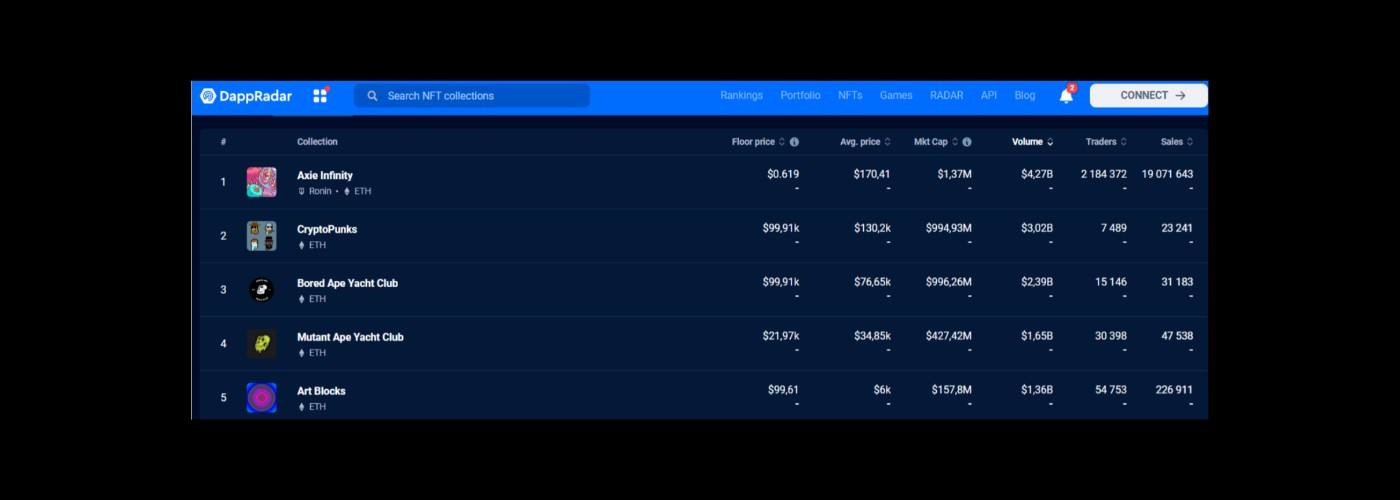What is a Decentralized Application (dApp)?

Description
Learn about decentralized applications, how they work, their benefits and drawbacks, and some dApp examples.
DApps is a common acronym for decentralized applications, consisting of programs or digital applications running either on a blockchain or a P2P network of computers.
What is the definition and meaning of dApp? These applications are decentralized and, because of this, not controlled by a single authority. DApps are created for various purposes, including finance, games, and social networking, and Ethereum is the platform for creating dApps. Ethereum is usually the platform of choice for creating dApps.
DApps meaning within the development of the entire cryptocurrency industry, is very high. This type of application maintains a high standard of decentralization and autonomy of blockchain-based products.
How do dApps work for the customer?
DApps have certain fundamental characteristics that define how they work. First, they are open source. This means that all changes made to a distributed application are first determined by consensus among many users. Therefore, the application's code base is available to all users for evaluation. In addition, their feature is decentralized storage, in which decentralized blocks are used to store data.
DApps are stored in blockchain systems, and their execution also takes place in such systems, usually Ethereum. The verification of these applications is done using cryptographic tokens. Therefore, these tokens are necessary to access decentralized applications.
While decentralization is the main feature that distinguishes dApps from traditional applications, certain aspects are common and are responsible for the functioning of dApps and their traditional counterparts. Like other applications, dApp uses external code to create web pages. However, its internal code is different because it uses distributed P2P networks to execute it. These internal codes are the reason that distributed a single authority does not control applications.
Another aspect that makes DApps different is that they are supported by smart contracts, unlike traditional applications that require the support of centralized servers and databases. These smart contracts are used to implement rules set in code to mediate transactions. They are stored in a blockchain. Small contracts are a small part of the overall application and are a set of back-end code. Therefore, a decentralized application requires a combination of multiple smart contracts along with an external third-party system to work.
Smart contracts run on a blockchain, which is a book of data records stored in blocks. These data blocks are distributed to decentralized locations, and cryptographic verification manages and links these blocks of data.

Benefits of dApps in the cryptocurrency ecosystem
Dapp development can be a complex process. However, this type of blockchain product is highly valued in the market and brings a lot of utility to the cryptocurrency ecosystem.
DApps crypto can simplify various processes. For example, some applications used for transactions can charge a certain amount of money if funds need to be transferred to a bank. In addition, the transaction may take several days to complete. However, when using decentralized applications to transfer money, the cost of the process is very low. In addition, the transaction is instantaneous. This means that time and money spent on transactions can be saved.
Since dApps are decentralized, they are not susceptible to cyber threats or attacks because they do not use physical devices to operate, which are usually prone to attacks. Therefore, such networks are more secure and do not suffer from downtime. Distributed applications can be accessed at any time.
DApps are applicable in various industries, such as gaming, management, finance, healthcare, and even file storage, which is another reason to use them. However, as mentioned, despite the differences in back-end operations, the mechanics and experience with dApps are largely the same.
Limitations of dApps for users and developers
What is a decentralized app? It is an important part of the transition from centralization to a future without censorship and restrictions.
But this segment is just developing so far, and it is impossible to rule out some mistakes and problems. After all, there are two sides to every coin.
Distributed applications are still in the early stages of development, and the industry has yet to address limitations such as scalability, code modification, and small numbers of users.
DApps require significant computing power and can overload the networks on which they operate. For example, to achieve the security, integrity, transparency, and reliability that Ethereum strives for, all validators must execute and store all transactions conducted on the network. This can exacerbate the system's Transactions Per Second (TPS) rate, leading to network congestion and overpricing.
It is also difficult to make changes to the dApp. To improve the user experience and security of the dApp, ongoing changes such as bug fixes, UI updates, and new features will likely be required. However, once the dApp is deployed on the blockchain, it will be difficult to change its internal code. Approving changes and enhancements requires the consensus of most nodes on the network, and implementation can take a long time.
The large number of dApps on the market makes it difficult to single out any one dApp and attract a large number of users; for a dApp to work efficiently, it must demonstrate network efficiency, and the more users it has, the more efficiently it can serve. The more users, the more reliable the dApp, and the more secure the dApp is against hackers tampering with the open source.
Popular dApp use cases: 1Inch, Chainlink, Aave, TraceDonate
As one of the fastest-growing areas of the blockchain sector, there are a number of dApps that are evolving significantly. What is a dApp crypto? And what are dApps crypto that havachievedve high popularity with cryptocurrency users?
Pancake Swap - This dApp crypto uses the Binance Smart Chain ecosystem to enable the exchange of BEP 20 tokens. Its notable advantages are the smooth user experience and the fact that users only have to pay a 0.2% exchange fee. It can also be connected to various cryptocurrency wallets.
1Inch - Designed as a decentralized exchange based on Ethereum, 1Inch has undergone an impressive evolution and expanded significantly. It is now a multi-network trading DEX, allowing users to leverage the liquidity of multiple decentralized exchanges using different blockchains.
Chainlink is one of the most well-known middleware, and Chainlink provides tamper-proof outputs and inputs, and computation for Oracle networks. It is currently being tested on Google's BigQuery PaaS data warehouse.
TraceDonate is a distributed application that charities and donors can use for their beneficiaries. The app builds stakeholder confidence that donations will reach those in need. Funds are stored in a digital wallet, and donors can track how their donations are spent.
Aave - Aave is one of the most popular open-source liquidity protocols based on DeFi technology and is known for providing full transparency to users. It allows investments, borrowing, and lending, as well as the payment of interest on deposits. Being decentralized, it guarantees complete anonymity to both borrowers and lenders.
How to connect to dApps?
To interact with the dApp, you first need a browser-compatible advanced wallet such as MetaMask, Trust Wallet, or Binance Chain Wallet. They take only a few minutes to install. Some of them also offer mobile versions for easy access.
Depositing BNB into a Trust Wallet
To use dApps with BSC, you'll need BNB to pay transaction fees. Go to Trust Wallet and click BNB Smart Chain; do not click BNB Beacon Chain. This option is for BEP-2 BNB in the BNB Beacon Chain and cannot be used for BSC transaction fees.
Click [Get], and you will see the BNB deposit address. You can then copy and paste this address into your wallet for withdrawal or scan the QR code to send money.
After confirming the transaction on the blockchain, the amount of BNB will be displayed on the main page of the Trust Wallet.
Add CAKE to the Trust Wallet list.
The default list of tokens in Trust Wallet does not include dApp tokens such as PancakeSwap (CAKE); to make CAKE visible in your wallet, you must first add it to the list.
Click Add Tokens and search for "PancakeSwap". CAKEs on different blockchains will appear. In this case, we are using BSC, so click the button next to [BEP-20 CAKE] and toggle it.
The CAKE should now appear in the list of tokens in the Trust Wallet.
Then connect the Trust Wallet to PancakeSwap - you can do this through the Trust Wallet's built-in mobile browser or desktop computer.
Conclusion
DApps are slowly gaining popularity because their true potential is clearly visible to people and businesses in India. DApps are constantly evolving, becoming more sophisticated and adding features that enhance their applications. The combination of innovation, creativity, and technology has led to the creation of dApps suitable for different sectors and companies in India.
Understanding and building dApp functionality require a good understanding of the blockchain ecosystem, as the blockchain ecosystem is a key element in dApp backend development in Mumbai, Delhi, Hyderabad, and all Indian states. As the use of blockchain technology continues to grow, so makes the career path and demand for blockchain specialists who can unlock the system's potential and create innovations such as dApps.Blockchain Developer at Simplilearn Planned courses such as Bootcamps help Indian people learn the basics of blockchain and develop skills that can further advance in this direction for Indian users.